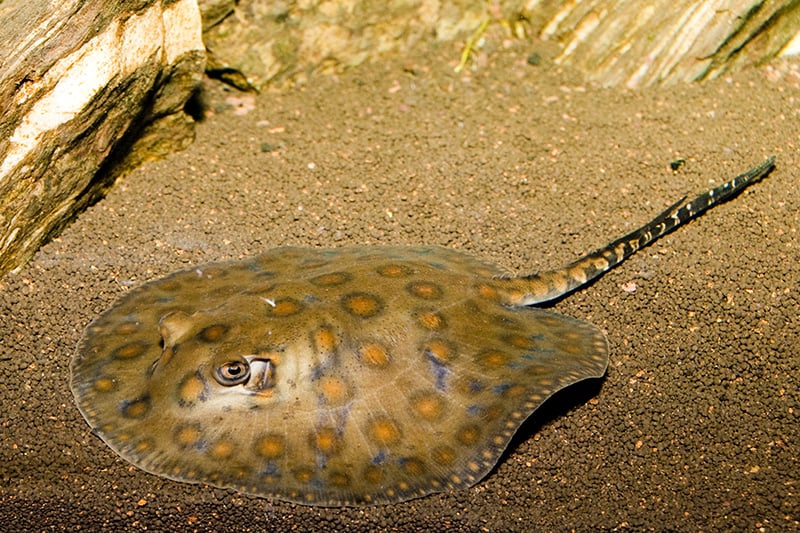For the first few feedings we impale food on a long pole and placed it very near the mouth to entice the ray to eat. Once they get the idea they readily eat anything meaty like squid, shrimp, and cut up fish.
The disk of theCalifornia Stingray or Round Stingray is nearly circular. The back of this species is brown, often mottled or spotted, and the underside it is white to orange.
The California Stingray or Round Stingray is one of six rays found in California waters which have a stinger on the tail. It can be distinguished from the others since it is the only one with a true tail fin. The others have either a whip-like tail or very short tail with no fin membrane.
For more Information on keeping marine fish see:
Guide to a Happy, Healthy Marine Aquarium
This stingray scored itself a yummy meal! The California Stingray, like other stingrays need a very large tank with a sandy bottom void of rocks and obstruction. They can become quite tame in captivity, however they need a tank that is at least 280 gallons to accommodate their 9″ body and even longer tail! They need cooler tanks with temperatures from 54 to 72˚F for long term survival.
- Beginner Fish – Saltwater fish for beginners
- Community Fish – Peaceful Saltwater fish
- Hardy Fish – Hardy Saltwater fish
- Kingdom: Animalia
- Phylum: Actiniform
- Class: Elasmobranchii
- Order: Rajiformes
- Family: Urolophidae
- Genus: Urobatis
- Species: halleri
Maintenance difficulty:
TheCalifornia Stingray or Round Stingray is hardy and easy to keep. They become quite tame in captivity.
Maintenance:
Feed all kinds of large meaty foods like small pieces of fish, squid, shrimp, crabs, prawns, molluscs, and live goldfish. Best to feed small amounts several times a day.
Habitat: Natural geographic location:
This species, the California Stingray or Round Stingray, occurs from Panama to Humboldt Bay, California, including the Gulf of California. California Stingrays or Round Stingrays are most abundant off southern California and northern Baja California at depths up to 70 feet. They like shallow, sandy areas.
Foods:
In the wild they obtain much of their food by burrowing in the substrate. Their diet includes worms, crabs, snails, clams and small fishes.
Social Behaviors:
Gets along with its own kind and other fish. Watch smaller fish as they could become lunch although they usually leave other fish alone unless they are acting sick or distressed.
Sex: Sexual differences:
Light: Recommended light levels:
Breeding/Reproduction:
Mating occurs from May to June and in December. There are one to six pups, depending upon the size of the female. It takes 3 months for the round stingray young to develop and they are approximately 3 inches wide at birth. Sexual maturity is reached in 2.6 to 3 years.
Temperature:
Best kept between 54 and 72 degrees Fahrenheit (12 to 22 degrees C).
Length/Diameter of fish:
California Stingray or Round Stingray adults can grow to 22 cm (9 inches) not including the tail. At 20 cm they weight about 1.5 lbs.
Minimum Tank Length/Size:
A minimum 75 gallon aquarium is recommended.
Water Movement: Weak, Moderate, Strong
Water Region: Top, Middle, Bottom
Usually found on the bottom, sifting through the sand. Will sometimes bury itself in the sand.
Availability:
This fish is available from time to time.
Featured Image Credit: iliuta goean, Shutterstock
